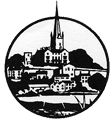NO RAIN (to speak of) IN SPAIN
The Society's 2014 foreign tour took place from 9th to 15th April. Not only was the weather unseasonably sunny and hot almost throughout - even the Spaniards were amazed - but our cultural program of visits was an unparalleled success, too. The 16 participants assembled very early on the Wednesday and had an uneventful journey to Madrid via Heathrow. The Hotel Catalonia Las Cortes was right in the centre of the old city and proved to be comfortable and friendly, as well as being within easy reach of the principal locations on our Madrid itinerary.
Thursday started with a short walk in the Parque del Buen Retiro, central Madrid's large principal green space, with its extensive boating lake and many varieties of trees, which were looking at their best, it being well into Spring there. The next stop was the nearby Museo del Prada, housing the massive 12th to early 19th C. collection of more than 20,000 paintings, drawings, prints and sculptures originally belonging to the Royal family but handed over to the nation in the early 19th C. The paintings include very many Goyas, and many others, too, by Velásquez, El Greco, Titian (and other Italian Masters), Peter Paul Rubens and Hieronymous Bosch to name but a few. Only about 1,300 items are on display - but, by the end of a few hours' viewing, it seemed like nearer the full 20,000!
After two or three hours of "free" time, which allowed inter alia for optional visits to the Museum of Modern Art (housing Picasso's Guernica), or the Botanical Gardens, or to bed for a well-earned rest, the marathon continued with a tapas meal in Plaza Santa Ana, followed by a lively performance of The Barber of Seville (noted more for its music than its plot) at a nearby 19th C. theatre.
Friday morning saw us walking the short distance from the hotel to the Museo Thyssen-Bornemisza, which houses two more large collections of paintings, amassed by Baron Hans-Heinrich T-B (enlarging that of his father, Heinrich T-B), both German industrialists; and that of Hans-Heinrich's wife, Carmen, the 1961 Miss Spain (ahem!) over 20 years his junior! The collections were re-located to Madrid in 1992 and bought outright by the Spanish Government in 1993. To many of us, these, taken together, were better than the Prado collection, as Hans-Heinrich's paintings included many more from Europe, America and even England - with a bias towards later centuries up to the 18th; and Carmen's were largely 19th and 20th C.
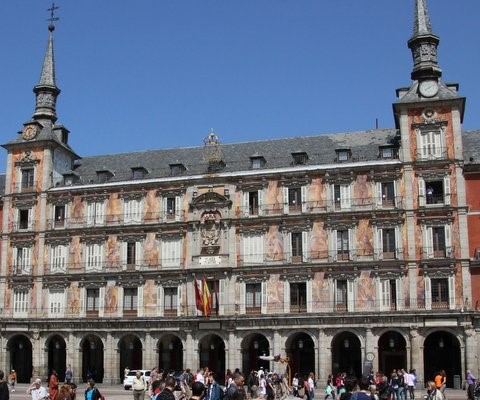 Then it was on, through more of the old city, to the impressive Plaza Mayor for lunch before a short walk to the Royal Palace. Officially the residence of the Royal family - but now used for official events only - this elegant building on the site of a 9th C. fort was completed in 1755 following the destruction by fire of the 16th C. castle. A modest baroque edifice, the Palacio Real de Madrid.
Then it was on, through more of the old city, to the impressive Plaza Mayor for lunch before a short walk to the Royal Palace. Officially the residence of the Royal family - but now used for official events only - this elegant building on the site of a 9th C. fort was completed in 1755 following the destruction by fire of the 16th C. castle. A modest baroque edifice, the Palacio Real de Madrid.
has 1,450,000 sq ft of floorspace and contains 3,418 rooms, being the largest palace in Europe by floor area. The interior of the palace is notable for its wealth of art and the use of many types of fine materials in the construction and decoration of its rooms. These include paintings by artists such as Caravaggio, Velázquez and Goya; and frescoes by Tiepolo among others. Other collections include the Royal Armoury of Madrid collection, porcelain, watches, furniture and silverware. One room houses the instruments comprising the world's only complete Stradivarius string quintet.
After seeing, non-stop, so many exquisite artefacts of "la Cultura Reale" some of us men were by now dreaming of Real Ale!
The evening's entertainment, over dinner, was a demonstration of Flamenco dancing in a venerable building close to the hotel. The music was provided by an authentic guitarist and a high-decibel male singer whose powerful renditions of voice music sounded not unlike a muezzin in overdrive, reflecting the Moorish roots of the genre. The dancers, two females and one young man, also gave powerful, dramatic individual displays with noisy foot stamping, sinuous movements and unmistakably sexual overtones. The effect of the young man's dancing on the demeanour of some of the lady members in our party was palpable!
On Saturday morning we visited yet another museum, The Lazario Galdiano Foundation, holding another formerly privately-held collection of principally Spanish paintings, plus some interesting furniture and other artefacts. However, having survived a surfeit of culture at the Prado, the Thyssen and the Royal Palace over the previous two days many of us felt rather overcome by an onslaught of more still. Relief was at hand: after a pavement-café lunch a coach was there to take us the 45 miles to Toledo.
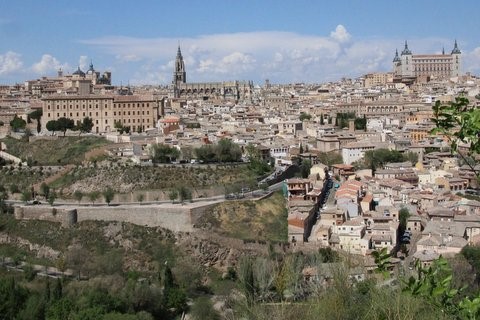 The old, walled city of Toledo, of pre-Roman origins and noted for the long-time peaceful co-existence of Moors, Christians and Jews, stands on a hill above the Tagus, which flows past on its way to Lisbon. Despite, as a UNESCO World Heritage Centre, being a magnet for tourists, Toledo retains considerable charm for its wealth of old buildings and its stunning position. Unfortunately, we could only see the outside of the cathedral, as it was closed ahead of a visit that evening by Queen Sofia for a concert as part of the city's celebrations for the 500th anniversary of the death of El Greco. He lived here from 1577 until his death in 1614, becoming one of Toledo's most famous adopted sons. We did, however, go to the quite small church of Santo Tomé to see his The Burial of the Count of Orgaz, one of his most famous works. After an enjoyable tour around the city it was time to walk down to cross the Tagus and re-board the coach to return for a last night in Madrid.
The old, walled city of Toledo, of pre-Roman origins and noted for the long-time peaceful co-existence of Moors, Christians and Jews, stands on a hill above the Tagus, which flows past on its way to Lisbon. Despite, as a UNESCO World Heritage Centre, being a magnet for tourists, Toledo retains considerable charm for its wealth of old buildings and its stunning position. Unfortunately, we could only see the outside of the cathedral, as it was closed ahead of a visit that evening by Queen Sofia for a concert as part of the city's celebrations for the 500th anniversary of the death of El Greco. He lived here from 1577 until his death in 1614, becoming one of Toledo's most famous adopted sons. We did, however, go to the quite small church of Santo Tomé to see his The Burial of the Count of Orgaz, one of his most famous works. After an enjoyable tour around the city it was time to walk down to cross the Tagus and re-board the coach to return for a last night in Madrid.
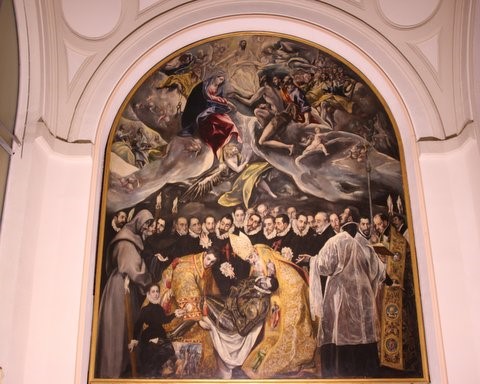
About 30 miles from Madrid, our first Sunday venue, beneath the Sierra de Guadarrama, was the town of San Lorenzo de El Escorial, famed for its monastery and basilica; and as a former Royal residence and now UNESCO World Heritage Centre. Built for King Philip ll, it was completed in 1584 and was occupied by him for long periods before his death there in 1598. The scale is dramatic, the immense monastery and catholic college standing before the large basilica, which, belying the austere exterior of all the buildings, has a very elaborately decorated interior and high altar. Such was the King's commitment to religion, not to say paranoia, that he had built, behind the rear and sides of the altar area, a very plain, modest suite of rooms for himself and his daughter, from which both could keep watch on the many daily services from their respective bedrooms immediately adjacent on opposite sides! We toured the basilica and also its crypt, which houses the caskets containing the remains of almost all the Spanish kings and queens (Hapsburg and Bourbon) and their families, from the 16th C. onwards.
Still in Leon & Castile, Salamanca (UNESCO again!) was our home for the next two nights, at the Hotel Abba Fonseca (nothing obviously to do with pop groups or port!) in the old city. The Tormes River, a tributary of the Douro, flows beneath the hills on which this delightful city stands, about 50 miles from the Portuguese border and 125 miles NW of Madrid. The university here is the oldest in Spain (its degrees being given universal validity by the Pope about a hundred years after its founding in 1134) and the fourth oldest in the western world. The old city, with its many university and religious buildings, is particularly attractive when the evening light causes its golden sandstones to glow almost pink.
A tour of the old city taking in certain of the University and other buildings and the semi-detached cathedrals (sic) was Monday's itinerary. The old cathedral, completed in the 12th C., became too small for a growing population so a much larger one, also essentially baroque, was started in the 16th C. on the adjacent site - with the intention that the old one would be pulled down when it was completed. Accordingly, the north transept was foreshortened and the new cathedral built adjacent on the resulting straight north wall of the old. After 220 or so years building the new they decided to keep the old one anyway! The new building still bears cracks and damage resulting from the massive Lisbon earthquake of 1755, also evident on a number of buildings we saw in Salamanca and elsewhere. An interesting feature of the new is the 90 metres-high dome above its transept: a dove centrally portrayed there looks miniscule from below but in fact its wingspan is nearly three metres!
A free afternoon gave a chance to explore more of the city's buildings and its many small public gardens; to visit the river with its 1st C. Roman bridge and adjacent ancient, headless bull statue; and, for those still with some energy, to climb up stairs to viewing points on the cathedrals or the Jesuit College, in some cases rewarded by close ups of the resident storks and their nests. A convivial group dinner in the Saladin Restaurant rounded off another long day. That night and the previous night there were religious processions (noisy or sepulchral ) in the streets as the Easter week got under way.
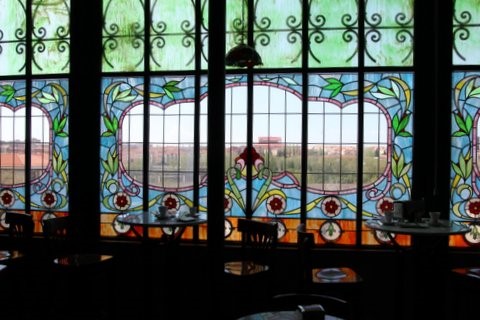 Our final day, Tuesday, started with another extra to the advertised itinerary: a visit to the Art Nouveau and Art Deco Museum, home to the remarkable and extensive collection of Manuel Andros Andrade, a local tannery owner, which he bequeathed to the city. There are many hundreds of items, housed in the delightful, restored iron and glass Casa Lis, with stunning art nouveau decorative glass north and south façades, the latter some thirty yards long and comprising two storeys standing elegantly above the Tormes River. There is a profusion of glassware, porcelain, enamel, chryselephantine sculpture, perfume bottles, furniture, and other artefacts, as well an immense collection of 19th C. porcelain dolls and mechanical toys, and even a small Fabergé egg. This was a very fine end to the cultural side of our trip.
Our final day, Tuesday, started with another extra to the advertised itinerary: a visit to the Art Nouveau and Art Deco Museum, home to the remarkable and extensive collection of Manuel Andros Andrade, a local tannery owner, which he bequeathed to the city. There are many hundreds of items, housed in the delightful, restored iron and glass Casa Lis, with stunning art nouveau decorative glass north and south façades, the latter some thirty yards long and comprising two storeys standing elegantly above the Tormes River. There is a profusion of glassware, porcelain, enamel, chryselephantine sculpture, perfume bottles, furniture, and other artefacts, as well an immense collection of 19th C. porcelain dolls and mechanical toys, and even a small Fabergé egg. This was a very fine end to the cultural side of our trip.
An uneventful afternoon coach journey back to Madrid's huge, modern airport and we were under way to Heathrow and thence by coach back to Herefordshire, arriving very late in the evening.
Looking back on the experience, the trip was extremely successful, if at times very full. The local guides we had in the Madrid museums and Royal Palace, in Toledo, in Escorial, in Avila and in Salamanca were all very knowledgeable on their subjects and, for the most part, very entertaining and with good spoken English. Our overall tour guide, fixer and companion throughout was Danny from near Barcelona, a sometime Mancunian, long settled in Spain, who kept us well informed on Iberian and Spanish history, its recent economy and social aspects, the Civil War, other politics, geography and the current Royal family. His good humour - if not all his many jokes - was very much appreciated.
Our thanks are due to Danny, to the local guides and to Norman Allen Group Travel's organising skills for an excellent trip; also to Frances Clarke for her initial involvement in planning and promoting the tour; and to Maureen Blunden for stepping in when Frances bowed out in December, and for keeping some sort of control over the party.
Philip Blunden
(Photos courtesy of Gerald Francis)

